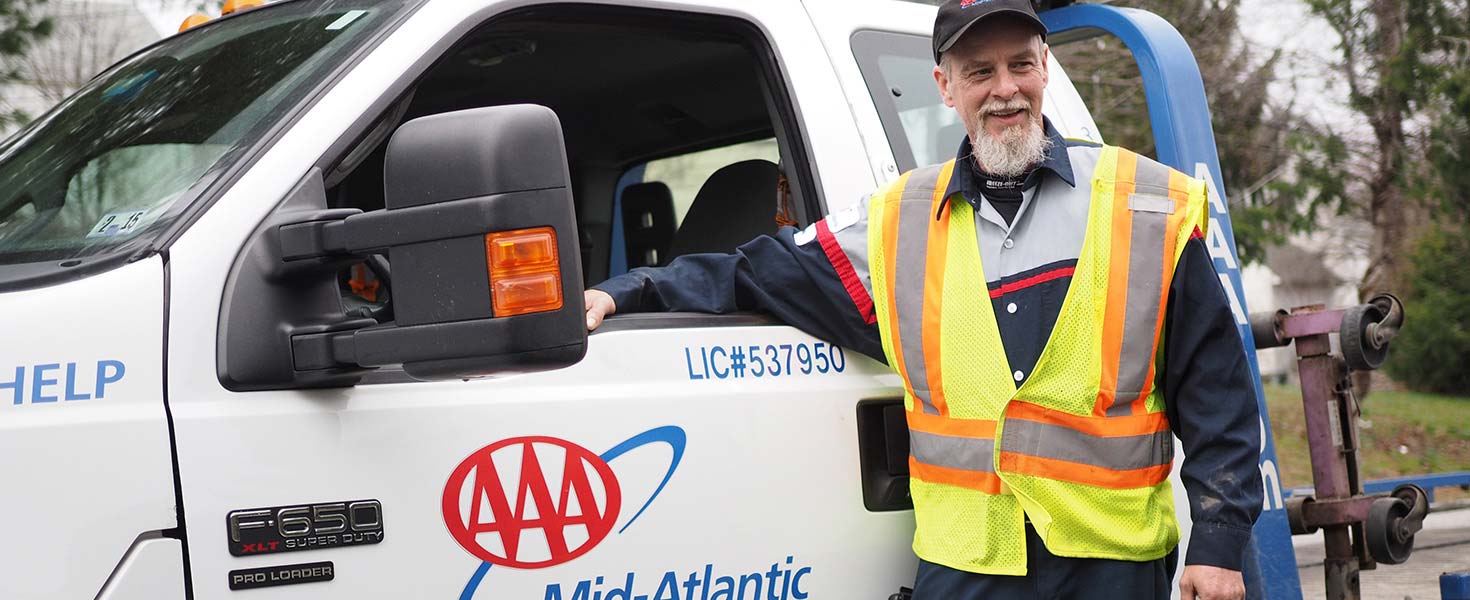
AAA ROADSIDE ASSISTANCE
Get the road service benefits you need so you’re never stranded.
Cars break down. Tires go flat. Batteries die. We lock our keys in the car or run out of gas. Even when we have a brand-new car, it happens. And it never seems to happen at a convenient time. There’s only one thing about needing road service that’s convenient—and that’s having AAA Roadside Assistance just a tap or call away, 24 hours a day.
For your protection, we’re taking special precautions against transmission of COVID-19.
Scroll down to find the answers to questions like, what Roadside Assistance covers, how do I track my Roadside Assistance driver, how much is AAA Roadside Assistance, and how do I choose the best plan for me.
Membership
AMERICA’S #1 ROADSIDE ASSISTANCE PROVIDER1
Imagine being stranded at two a.m., having your kids in the car with you, or your daughter’s car breaks down and you—or they—don’t know who to call for roadside service.
Worse yet, you don’t know who will answer that call. You need someone you can trust to give you, or one of your family members, help on the highway. That’s why all AAA drivers are background checked.2 And, it’s why we show the driver’s photo on the AAA Mobile App. So you know who’s coming to help when your car lets you down.
When you’re looking for “roadside assistance near me,” you can’t do any better than AAA. With Clubs all across the U.S.A. and Canada, we help more than 33,000,000 motorists a year.3 And more than 63,000 road service trucks,4 plus the friendly, well-trained service technicians and call-takers, are all at the ready so there’s always help nearby.
What does Roadside Assistance Cover?
It varies from company to company. But AAA Roadside Assistance is proud to be the nation’s #1 Roadside Assistance provider.1 Our Members recommend us more than any of our competitors because we do more than provide friendly, trusted roadside service when you need it for towing, tire change, and battery, out-of-fuel, stuck-vehicle, and lock-out service.
We also provide bicycle coverage when your bike breaks down and you’re on the road. You can add RV coverage if you like to take road trips. And, AAA Members get lots of extras including free Identity Theft Monitoring with ProtectMYID® from Experian—with membership.
How do I track my Roadside Assistance?
It’s easy to request roadside service—and to track it--when it’s on it’s way. Once you’ve become a AAA Member, simply download the free AAA Mobile App. That way, when you need a tow, battery jump, tire change, or any other covered service, simply tap your app. You can watch the service vehicle as it’s driving to you, and get information on the driver, too.
How much is AAA Roadside Assistance?
The cost of AAA Roadside Assistance depends on your needs. We offer three plans: Classic with up to 5 miles of free towing; Plus with up to 100 miles of free towing; and Premier, with up to 100 miles of free towing plus one tow up to 200 miles each year.5
How do I choose the best plan for me?
It’s up to you. You can choose by price alone, or you can choose your AAA Roadside Assistance plan based on how many miles you drive to work or college—and if your family likes to take road trips. Many of our Members prefer to have the plan that will get their car back home safely and to a mechanic they can trust. That way, they’re not inconvenienced by trying to get their vehicle fixed far from home.
When you start to enroll in AAA Roadside Assistance, you’ll see pricing for all three plans as well as how much your dues would be depending on the number of drivers you add to your membership. You may enroll as many household drivers as needed to keep everyone in your family safe on the road.
You can enroll in AAA Roadside Assistance online, by phone, or in the AAA Store nearest you.
1 Based on the 2017 AAA U.S. Market Track Survey.
2 Background checks are performed by a third party.
3 R12 December 2017 Tableau/EDR. Actual: 33,191,978.
4 Club self‐reporting for year‐end 2018. Actual: 63,604.
5 This is a general description of Classic, Plus, and Premier Membership benefits. Full details will be provided to you when you join AAA, or upgrade your membership. If you upgrade from Classic to Plus or you purchase a Premier Membership, you can begin using the additional Plus services seven (7) days after your Plus Membership has been processed.
AAA IN THE NEWS
AAA CAUTIONS CONSUMERS: DON’T BUY THE HYPE
New Research Indicates Automakers’ Marketing of Driver-Assist Technologies May Be Misleading
TOWSON, MD (Thursday, September 10, 2020) –– Motorists using new in-vehicle technologies with names like AutoPilot or ProPilot may believe the driving assist systems are more capable than they actually are, according to new research from the AAA Foundation for Traffic Safety. AAA is urging automakers to err on the side of caution when it comes to naming and marketing the new technology. The auto club is also encouraging car dealers not to overhype the vehicle’s technological capabilities. More importantly, drivers are reminded that they, too, play a role in understanding the limitations of the technology and always remaining engaged when behind the wheel, cautions AAA Mid-Atlantic.
“As exciting as these new technologies may be, they are not as fully capable as some of their names might suggest,” says Ragina C. Ali, Manager of Public and Government Affairs for AAA Mid-Atlantic. “It is critical that drivers understand that there are limitations to the technology and they should always remain engaged when behind the wheel.”
Active driving assistance systems (ADAS) combine vehicle acceleration with braking and steering. Researchers found consumer information that stresses convenience and capabilities while minimizing limitations can inflate expectations regarding what the system can do and the situations that it can handle. AAA warns that a false sense of system capabilities created by marketing campaigns can lead to dangerous scenarios on the road.
“Based on data collected from our research, subtle differences in tone and emphasis significantly influenced people’s understanding of the technology and their expectations of its capability,” said Dr. David Yang, executive director of the AAA Foundation for Traffic Safety. “These systems assist the driver and take some of the stress out of driving, but they don’t eliminate the need for drivers to pay attention.”
In this latest AAA Foundation study, 90 research participants received a brief overview of an active driving assistance system with a realistic but fictitious name. Before driving the same vehicle, half of the participants were told their system was called “AutonoDrive” and were given an upbeat training that emphasized the system’s capabilities and driver convenience. The other half of the participants were told their system was named “DriveAssist,” and their training placed greater emphasis on the system’s limitations and driver responsibility. Participants trained on AutonoDrive came away with greater confidence — and in some cases, overconfidence — in the system.
After completing the training and driving the test vehicle, 42% of the participants using AutonoDrive, said its name made the system sound more capable than it is, while only 11% of DriveAssist users felt the same. Also, compared to those who learned about DriveAssist, participants trained on AutonoDrive were more likely to believe erroneously that the system would [let them talk on the phone, eat, automatically avoid a collision, or automatically reduce speed on a tight curve].
“From our research, it’s clear that education and training can influence users’ expectations, how they will interact with and their behaviors when using new vehicle technologies,” added Yang.
Potential consumer misunderstanding of new vehicle technology needs to be addressed. In a previous survey, 40 percent of Americans told AAA they expect active driving assistance systems, with names like Autopilot and ProPILOT, to have the ability to drive the car by itself. AAA recommends that automakers provide consumers with information that is not only technically accurate but also balanced in terms of setting expectations that match what consumers will ultimately experience on the road. For consumers, there must be an emphasis on driver engagement and understanding the limitations of these technologies. Car dealers have a responsibility to educate car buyers on these technologies, but not to oversell a vehicle’s bells and whistles.
“Automakers are in the business of selling vehicles. Understandably, they will emphasize convenience and system capabilities in their marketing campaigns. But, their marketing campaigns, materials and consumer information should not mislead motorists,” said Jake Nelson, AAA director of traffic safety advocacy and research. “Words matter. We can do better by taking care to be more realistic in setting expectations for consumers such that the sale of a new vehicle does not come at the expense of safety.”
Drivers have a role to play, too. They are responsible for taking the time to understand the technology in their vehicle. New features, functions, and limitations should be understood before leaving the lot. Additional AAA Foundation research examined active driving assistance in on-road driving with research participants and found that when motorists receive detailed, comprehensive training on the system, they initially pay more attention to the overall driving task.
To reduce misuse or overreliance on the systems, AAA recommends that new vehicle owners follow this PLAN:- Purpose – Learn the purpose of active driving technology by reading the vehicle’s owner’s manual and visiting the manufacturer’s website.
- Limitations – Understand what the technology cannot do; do not make any assumptions about automation. An active driving system should not be confused with a self-driving one.
- Allow Time for Testing – Allow time for safe on-road testing, so drivers know exactly how this technology works in real driving situations.
- Never Rely On It – Do not rely on this technology; instead, act as if the vehicle does not have it with the driver always prepared to retake control if needed.
For more information, visit AAAFoundation.org and Newsroom.AAA.com.
About AAA Foundation for Traffic Safety: Established in 1947 by AAA, the AAA Foundation for Traffic Safety is a nonprofit, publicly funded, 501(c)(3) charitable research and educational organization. The AAA Foundation’s mission is to prevent traffic deaths and injuries by researching their causes and by educating the public about strategies to prevent crashes and reduce injuries when they do occur. This research develops educational materials for drivers, pedestrians, bicyclists and other road users.







